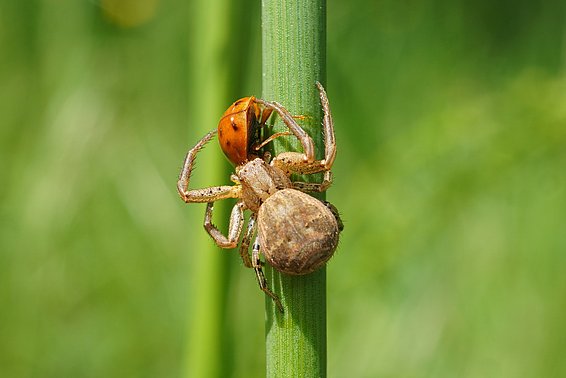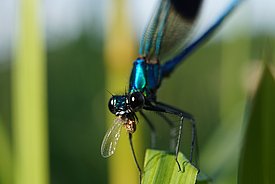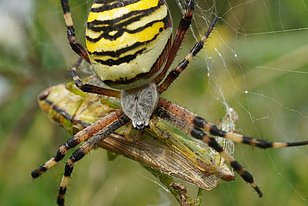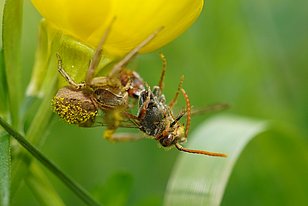17.10.2024 | Isabel Plana/Eawag | WSL News
Insects and spiders are important elements in the food webs of aquatic and terrestrial ecosystems. With declines in their biodiversity, the food supply for birds, fish, reptiles, amphibians and small mammals is not only becoming scarcer, but also poorer in important fatty acids, as an international research team led by scientists from Eawag and WSL reports in the journal Science.
Animals not only need sufficient calories to function, but also essential nutrients — including omega-3 and omega-6 polyunsaturated fatty acids (PUFA). Insects and arachnids are an important source of these essential fatty acids for birds, hedgehogs, lizards and the like. However, the content depends on the specific types of insects and spiders consumed. Aquatic insects, such as caddisflies or dragonflies, contain significantly more omega-3 long-chain (LC) PUFA than terrestrial insects because omega-3- LC-PUFA rich algae form the base of the food chain in aquatic ecosystems.
The content of fatty acids can also accumulate throughout food chains: a mayfly often contains more than the algae it feeds on, but less than the fish that preys on mayflies. There are existing studies on this, as well as many studies on how plant or algal biodiversity affects biomass availability in ecosystems. “However, little is known about the effect of insect and arachnid biodiversity on the availability of fatty acids in an ecosystem’s food web,” says Cornelia Twining, group leader “Food Web Ecophysiology” at the aquatic research institute Eawag and professor at ETH Zurich. She and her colleagues aimed to close this knowledge gap.
Over 700 land and water ecosystems examined ¶
The researchers used a data set with over half a million observations of around 7600 insect and spider species in Switzerland. The approximately 400 aquatic ecosystems and 300 terrestrial ecosystems in the study vary in land use — some in natural habitats such as extensive meadows or forests, others in agricultural areas or in the middle of a city. For each of these ecosystems, the researchers calculated the biomass and biodiversity of insects and arachnids and the amounts of different key PUFAs they provide in total. “We were interested in how land use shapes energy and nutrient availability and whether there are key differences between aquatic and terrestrial ecosystems,” says Ryan Shipley, researcher at the WSL institute for snow and avalanche research SLF and the lead author on the study. “Land use change ranks among the most urgent global challenges, making it essential to understand how human activities impact fundamental ecosystem functions," explains Shipley.
Fatty acid content in the food web declines with decreasing biodiversity ¶
Data analysis revealed that in all the studied communities, a decrease in insect and spider biodiversity was accompanied by a decline in biomass and the content of key fatty acids. "In terrestrial communities, we also see significant differences depending on land use," says Twining. Even when biodiversity is the same, insect and spider communities in a city park typically provide fewer omega-3 LC-PUFA than those in a forested area. "This is partly due to the different species composition of these populations, and partly because the biomass is smaller in urban areas: there are also fewer predators like spiders or large beetles, which accumulate LC-PUFA in terrestrial systems," Twining explains.
"What surprised us was that in aquatic communities, the effect of land use is much less pronounced. For a given number of species, streams in urban areas have a similarly fatty acid content to streams in forests." The researchers explain this by noting that aquatic insects generally contain higher amounts of Omega-3 LC-PUFA compared to terrestrial taxa. On land, the differences are more significant: when predators like spiders, which accumulate high amounts of essential fatty acids, disappear from the ecosystem, the impact is considerable. “However, this does not mean that the biodiversity of aquatic insects is any less important,” says Twining.
Aquatic ecosystems are a crucial fatty acid source, especially in urban areas ¶
On the contrary: aquatic ecosystems can be key sources of fatty acids for terrestrial food webs. In urban areas, where the loss of insects and spiders is particularly high due to increasing human land use pressure, aquatic insects become an even more important source of essential fatty acids for birds, bats, or lizards. This “superfood” is unfortunately increasingly accompanied by pollutants in streams, rivers, and lakes, though. “Our study shows how important it is to protect biodiversity, especially in agricultural and urban areas, and to improve water quality in order to preserve food webs for ecosystem functioning”, Twining emphasizes.
Blue-Green Biodiversity Research Initiative
The research project «Predator coupling of aquatic and terrestrial ecosystems: the importance of nutritional diversity of prey» contributes to the Blue-Green Biodiversity Research Initiative – an Eawag-WSL collaboration that focuses on biodiversity at the interface of aquatic and terrestrial ecosystems. The initiative is funded by the ETH Board.
Original publication ¶
Shipley et al., Consumer biodiversity increases organic nutrient availability across aquatic and terrestrial ecosystems, Science (2024). DOI: 10.1126/science.adp6198
Cooperations ¶
- Eawag
- WSL
- University of Applied Sciences and Arts of Southern Switzerland SUPSI
- University Zurich
- University Brest (France)
- Wasser Cluster Lunz (Austria)
- Technical University Cottbus-Senftenberg (Germany)
- University Innsbruck (Austria)
- Danube University Krems (Austria)
- ETH Zurich
Contact Eawag ¶
Kontakt WSL ¶
Copyright ¶
WSL and SLF provide image and sound material free of charge for use in the context of press contributions in connection with this media release. The transfer of this material to image, sound and/or video databases and the sale of the material by third parties are not permitted.





